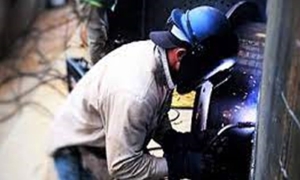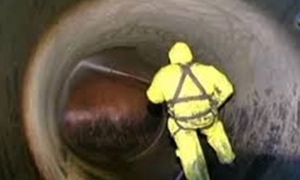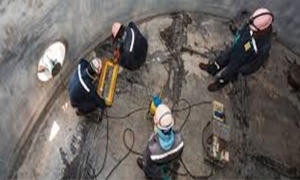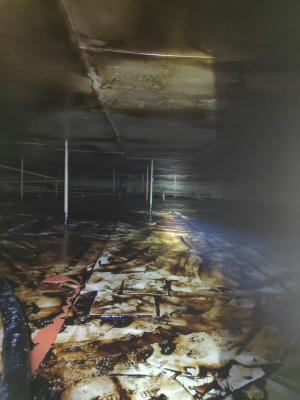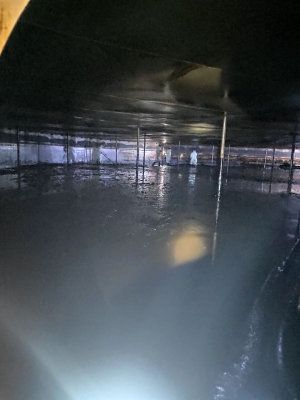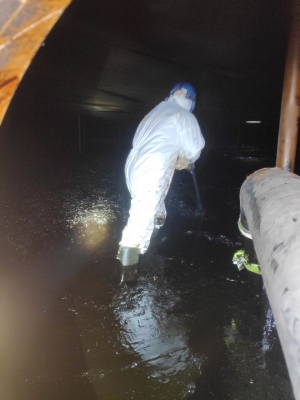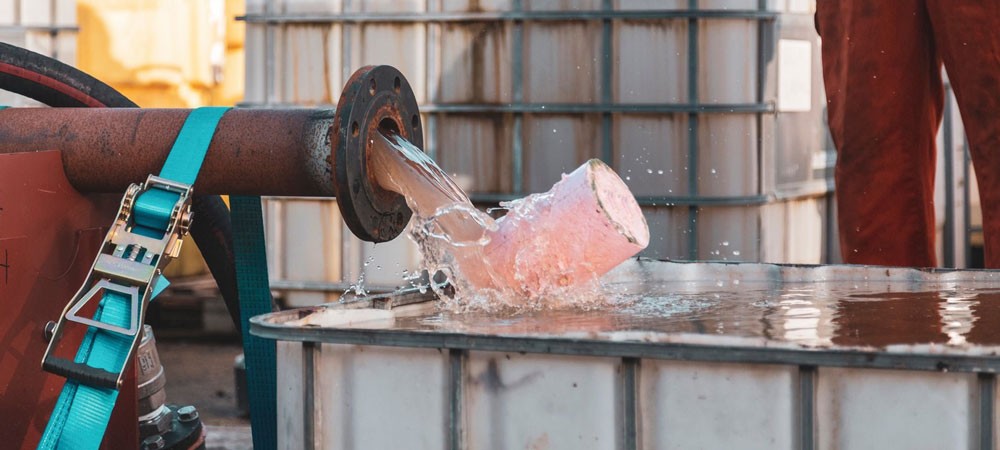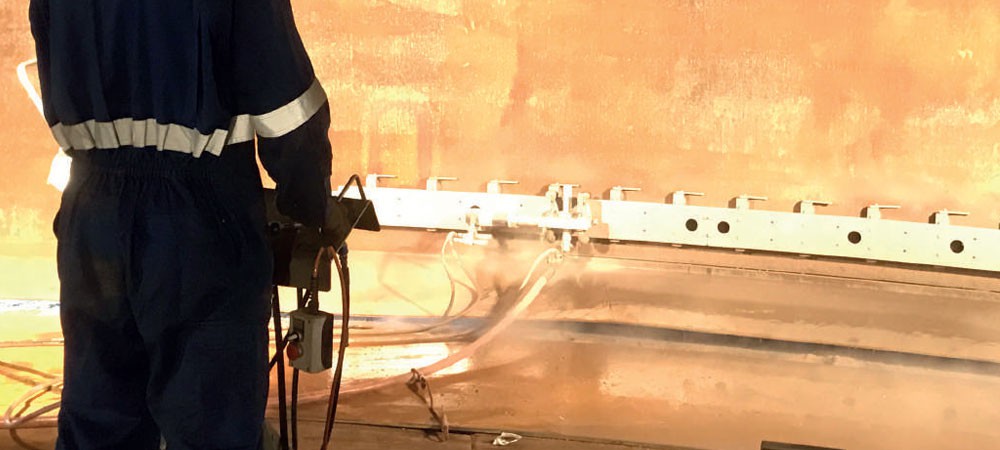Tank Cleaning & Maintenance

Tank Cleaning & Maintenance
EMBARK delivers tank cleaning services to meet your maintenance and regulatory requirements for any type of tank employed in the production or storage phases. We provide a wide range of services to effectively complete all phases of maintenance including cleaning, inspecting, repairing, and coating.
EMBARK routinely develops customized procedures and planned work schedules for tank cleaning projects to ensure safe, efficient, and environmentally sensitive operations. By maximizing our specifically designed work schedules, we can minimize interruptions to facilitate production.
Total cleaning costs are reduced by incorporating EMBARK's longstanding experience, new technologies, and proven processes. EMBARK uses desludging nozzles, remotely operated vehicles, cameras, and tools for cleaning and inspection to minimize or eliminate risks with confined space entry. Automated tools for tank cleaning provide safer and more effective solutions.
Our focus is to provide you with an expedited service while ensuring quality, safety, and protection of personnel and the environment. We work closely with you during the planning stages to determine the type of tank cleaning that is required based on an assessment of substance identification, hazards, and the tank condition. We then develop a Project Execution Plan that would outline critical project areas such as the scope of work, risk mitigation, HSE, QA/QC, scheduling/planning, and detailed project management.
TANK CLEANING & MAINTENANCE SERVICES
EMBARK has the expertise and fleet required to perform tank cleaning for various tank types for residential, commercial, and industrial requirements.
EMBARK can carry out cleaning operations both manually (personnel and jetting lances) and automatically (remotely operated cleaning robots) as required.
Industrial plants store water and chemical liquids in huge storage tanks. Generally, they store the products in underground or above-ground storage tanks.
Aboveground storage tanks (ASTs) can be up to 300 feet in diameter and usually contain between 500,000 to 12 million gallons.
The Underground storage tanks (USTs) are preferred by gas stations and these tanks can hold 6,000 to 10,000 gallons of products.
Currently, tank owners of the USA follow American Petroleum Institute (API) 653 regulation as the industry standard for AST evaluation, inspection, testing, and repair.
API 653 states regular inspection of storage tanks is necessary to determine corrosion rates.
How to Clean a Storage Tank?
Tank contractors must drain out the liquid from the tank until the tank does not lose suction from its low-suction nozzles. Now after performing this task, a professional tank cleaning company will follow these basic steps:
- Lockout electrical connections from mixers, pumps, and other mechanical equipment
- Disconnect the tank from the system by removing valves and draining down lines as well as installing the right sizes of pipeline flanges and blind flanges on tank nozzles
- Use a vacuum truck or other pumping system to remove the remaining liquid from the tank
- Vent the tank mechanically and perform gas-freeing processes to remove the dangerous vapors. The LEL (lower explosive limit) must be less than 10.
- Clean the interior of the tank, the confined space of the tank needs access following API standards.
- Use a vacuum truck to remove the final puddles of the liquid by squeegeeing the floor of the tank
- Power washes the walls, floors as well as the underneath of the floating roof
- Keep the roof pontoons of the floating roof under check to clean the residual vapors if necessary
- Keep an eye on the seals of the floating roof tank to look for product and vapor
- Inspect for hidden vapors to confirm your tank is vapor-free and clean.
Issues that can arise while Tank Cleaning - Faulty draining system of the products
- Unknown conditions of the tank can delay the completion of the work
- Petroleum storage tanks are risky due to their toxicity and flammability feature
- Improper ventilation system
- Faulty personal protection equipment (PPE)
- Extreme weather conditions
- Activities of the surrounding areas affect the condition of the confined space
GSC Tanks is a manufacturer of premium quality storage tanks. The company takes great care while designing and building its tanks.
TANK MAINTENANCE
Every water tank must be periodically maintained to ensure the long life of the tank and the quality of water within the tank. Some tanks, such as the reinforced concrete tanks often used for ground-level or standpipe reservoirs, have lower maintenance costs over the life of the structure when compared with steel tanks. But all types of tanks require at least some maintenance.
Maintenance can be considered a cost-saving measure. Periodic maintenance is usually much cheaper than the large repairs which will be necessary for un-maintained tanks. The cost of the inspection is an insurance policy against premature failure of the tank.
The tank's paint coating requires the most maintenance since it must be replaced periodically. When the coating is not well maintained, the tank will have to be repaired. The repair will usually cost two and a half times more than the cost of the original coating.
In addition to the financial cost associated with replacing badly maintained coats of paint, the coatings applied on such surfaces are usually lower in quality due to adverse application conditions. Seventy-five percent of all coating failures are attributable to deficient surface preparation or to improper application of the paint. These failures lead to downtimes during which the tank cannot be used while it is being repaired. The downtime and loss of facility production can lead to potentially staggering costs.
Formal coating inspections and the associated maintenance will vastly increase the probability of achieving a successful coat application that will protect the design life of the system. They will prevent costly repairs and are financially responsible in the long run.
PREPARING FOR MAINTENANCE
Inspections determine the need for maintenance. Then the tank must be dewatered, and the surface prepared for maintenance.
The first step during many maintenance procedures is to drain all of the water out of the tank. Before dewatering any potable water storage vessel, notice should be given to the state's Department of Environmental Management to allow time for any problems to be resolved by state and local officials. Insurance carriers should also be notified before dewatering and inspection occur.
Next, the structure must be prepared for maintenance. This preparation is a very important part of the process. If preparation is poor, the maintenance job will be poor. The interior and exterior surfaces must be cleaned of all rust scale, paint scale, blisters, rust, dirt, and growths. This cleaning can be achieved through any of several methods - using wire scrapers, sandblasting, flame cleaning, and so on.
After cleaning the surface, loose rivets must be replaced, and damaged seams must be welded.
Curing
The tank must be allowed to dry, or to cure, before being refilled with water and put back into service. The paint on the inside of the tank may take longer to cure, especially during the winter. Some types of paint, such as high-build epoxies, will be problematic if applied during the winter. Instead, high-solid vinyl should be used during these months since it will cure more reliably.
Sterilization
If a tank has been emptied for inspection, cleaning, painting, or for any other purpose, the tank must be thoroughly sterilized before being put back into service. Outside demands should never be allowed to force a tank back into service before it is properly cured and disinfected.
The structure should be thoroughly disinfected and chlorinated in accordance with Plumbing Codes before being used again. Bacteriological samples must be taken and approved and a copy of the report must be sent to the Health Department.
A suggested method for sterilizing a tank is explained below:
- Fill the tank 1/2 to 3/4 of the way full of water.
- Mix the disinfectant into about ten gallons of water and pour it into the tank. The amount of disinfectant to be added will depend on the capacity of the tank. You should add 12 pounds of HTH or Perchloro or 10 gallons of 10% sodium hypochlorite for every 20,000 gallons of water that the tank will hold. So, if you are disinfecting a 75,000-gallon tank, you can either add 45 pounds of HTH, 45 pounds of Perchloro, or 37.5 gallons of sodium hypochlorite.
- Completely fill the tank with water. This will evenly mix the disinfectant into the water.
- Permit the tank to stand for 24 hours, if possible, but for no less than 6 hours.
- Either pump or drain the strong, chlorinated water to waste.
- Refill the reservoir and collect samples for submission to the laboratory for bacteriological analysis.
An alternative method may be used by experienced personnel:- Wash down all surfaces thoroughly.
- Spray the bottom, sidewalls, and top with a hypochlorite solution containing at least 200 ppm of chlorine. The person in the tank must take special precautions. He or she must wear an effective gas mask and must be roped to an attendant on the outside of the tank.
- Fill the tank and collect samples for bacteriological analysis.
Annual Maintenance Service
Annual maintenance service contracts are an alternative to hiring an inspector to periodically inspect a water tank and recommend maintenance. Under this type of plan, a company is hired to clean the tank once a year, inspect the tank, and make all necessary repairs including painting, if necessary. In most plants, the entire tank is thoroughly cleaned and given a coat of paint every fifth year.
Annual maintenance service contracts have become popular in municipalities with tanks and towers with capacities of less than 250,000 gallons. The company hired will often require that their own company restores the tank before entering a contract for annual maintenance service. Then the company agrees to inspect and maintain the tank yearly for a set length of time, often for twenty years. Due to municipal changes, some companies will allow a municipality the right to cancel or renew the contract on a yearly basis on the anniversary date.
Since the maintenance company will be given exclusive responsibility for the upkeep of the tank, great care should be taken in selecting such a company. The company must conduct work with integrity, honesty, and professionalism. In addition, Comprehensive Liability and Workmen's Compensation Insurance should be carried on each contract to ensure the performance of the maintenance work. The waterworks should also demand a corporate bond, not an individual bond.
If an honest, reliable contractor is selected to perform the work, then annual maintenance service contracts can be a good choice for the maintenance of water storage facilities.
